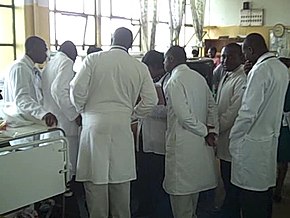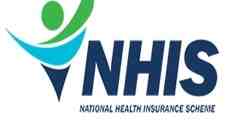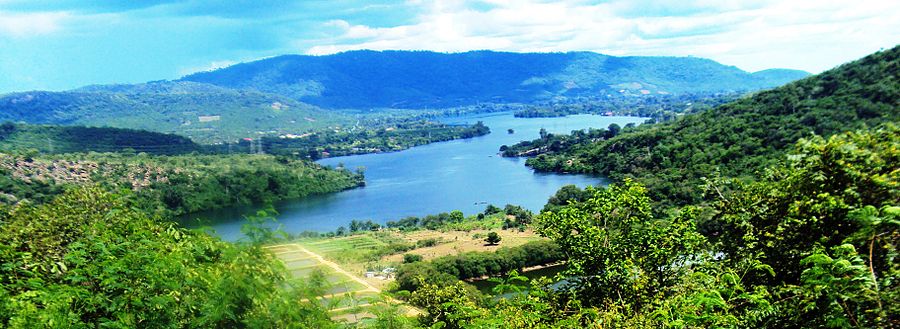Health in Ghana
 | |
|---|---|
| Health indicators | |
| Life expectancy | 66 |
| Infant mortality | 39 |
| Fertility | 2.12 |
| Sanitation | 14% (2010) |
| Smoker | 1% |
| Obesity female | 7% |
| Obesity male | 2% |
| Malnutrition | 1% |
| HIV | 0.7% |
Health in Ghana includes the healthcare systems on prevention, care and treatment of diseases and other maladies.
History


In the 16th century, traditionally, village healers and clerics were the primary care givers, offering herbal remedies. Though herbalists have traditionally offered the most ready treatment of illness, premodern traditional beliefs stressed the combination of spiritual and physical healing. Western medicine was introduced by Christian missionaries to the Gold Coast in the 19th century. This region was most involved in the development of a new health care system.[1]
A pre-medical department was formed initially, and in 1878, the Towns, Police, and Public Health Ordinance was enforced under its direction, initiating the construction and demolishing of infrastructure, draining of the streets, and issuing of fines to those that failed to comply with the heads of the colony. In 1893, a Public Works Department was introduced to implement a working sanitation system for the colony.[1]
In the 1880s, a Medical Department was formed, bringing about an introduction to a formal medical system, consisting of a Laboratory Branch for research, a Medical Branch of hospitals and clinics, and the Sanitary Branch for public health. After the war, the central government made a concentrated effort to expand western style medical facilities; and after World War II, both the World Health Organization and the United Nations Children's Fund had been active in providing money and support to provide additional western medical care in Ghana.[1]
Healthcare


In Ghana, most health care is provided by the government and largely administered by the Ministry of Health and Ghana Health Services. The healthcare system has five levels of providers: health posts which are first level primary care for rural areas, health centers and clinics, district hospitals, regional hospitals and tertiary hospitals.
These programs are funded by the government of Ghana, financial credits, Internally Generated Fund (IGF), and Donors-pooled Health Fund.[2] Hospitals and clinics run by Christian Health Association of Ghana also provide healthcare services. There are 200 hospitals in Ghana. Some for-profit clinics exist, but they provide less than 2% of health care services.
Health care is very variable through Ghana. Urban centres are well served, and contain most hospitals, clinics, and pharmacies in the country. Rural areas often have no modern health care. Patients in these areas either rely on traditional African medicine, or travel great distances for health care. In 2005, Ghana spent 6.2% of GDP on health care, or US$30 per capita. Of that, approximately 34% was government expenditure.[3]
In 2013, life expectancy at birth is 66 years with males at 65 years and females at 67 years,[4] and infant mortality is at 39 per 1000 live births.[5] The total fertility rate is 2.12 children per woman among the 15 million Ghanaian nationals. There was about 15 physicians and 93 nurses per 100,000 persons in 2010.[6]
5.2% of Ghana's GDP was spent on health in 2010,[7] and all Ghanaian citizens have access to primary health care 97.5% of the Ghana population.[8] Ghana's universal health care system has been described as the most successful healthcare system on the Africa continent by the renowned business magnate and tycoon Bill Gates.[8]
National Health Insurance
| National Health Insurance Scheme | |
 | |
| Agency overview | |
|---|---|
| Formed | 2003 |
| Jurisdiction | |
| Parent agency | Parliament of Ghana |
| Website | Official Website |
Ghana has a universal health care system, National Health Insurance Scheme (NHIS),[9] and until the establishment of the National Health Insurance Scheme, many people died because they did not have money to pay for their health care needs when they were taken ill. The system of health which operated was known as the "Cash and Carry" system. Under this system, the health need of an individual was only attended to after initial payment for the service was made.[10] Even in cases when patients had been brought into the hospital on emergencies, it was required that money was paid at every point of service delivery. When the country returned to democratic rule in 1992, its health care sector started seeing improvements in terms of:
- Service delivery
- Human resource improvement
- Public education about health condition
even with these initiatives in place, many still could not access health care services because of the cash and carry system.
The idea for the National Health Insurance Scheme (NHIS) in Ghana was conceived by former president John Kufuor who when seeking the mandate of the people in the 2000 elections, promised to abolish the “cash and carry system” of health delivery.[11] Upon becoming president, former president Kufuor pushed through his idea of getting rid of “cash and carry” and replacing it with an equitable insurance scheme that ensured that treatment was provided first before payment. In 2003, the scheme was passed into law. Under the law, there was the establishment of National Health Insurance Authority which licenses, monitors and regulates the operation of health insurance schemes in Ghana. Like many countries in the world, Ghana's health insurance was fashioned out to meet specific needs of its citizens. Since its inception, the country's health facilities have seen constant rise in patient numbers and a considerable reduction in deaths.
Disease

According to the World Health Organization, the most common diseases in Ghana include those endemic to sub-Saharan African countries, particularly: cholera, typhoid, pulmonary tuberculosis, anthrax, pertussis, tetanus, chicken pox, yellow fever, measles, infectious hepatitis, trachoma, malaria, and schistosomiasis. Though not as common, other regularly treated diseases include dracunculiasis, dysentery, river blindness or onchocerciasis, several kinds of pneumonia, dehydration, venereal diseases, and poliomyelitis.[12]
In 1994, the WHO reported malaria and measles were the most common causes of premature death. In 1994, children under five, 70 percent of deaths were caused by an infection compounded by malnutrition.[12] A 2011 report by the Ghana Health Service said that malaria was the primary cause of morbidity and about 32.5 percent of people admitted to Ghanaian medical facilities were admitted because of malaria.[13]
HIV/AIDS
Like other countries worldwide, HIV/AIDS is present in Ghana.[14] In 2012 there were an estimated 200,000 people infected with the virus and as of 2014 there is an estimated decrease of 150,000 people infected with the virus.[14]
The HIV prevalence rate decreased from 1.3% in 2012 to HIV prevalence rate standing at 0.8 percent as of 2014.[14]
In response to the HIV epidemic, the Government of Ghana established the Ghana AIDS Commission, which coordinates efforts amongst international organizations and other parties to support education about eradication of HIV/AIDS throughout Ghana by the year 2022.[14]

Women's health

The health of women in Ghana is critical for national development. Women’s health issues in the country are largely centered on nutrition, reproductive health and family planning.[15] Reproduction is the source of many health problems for women in Ghana. The Ghana Living Standards Survey Report of the Fifth Round revealed that about 96.4% of women reported that they, or their partners, were using modern forms of contraception.[16]
This statistic has significant importance in reducing the spread of HIV/AIDS, which affected 120,000 women in Ghana in 2012 (of the 200,000 people living with the disease in Ghana in 2012).[17] Interventions for improving the health of women in Ghana, such as the Ghana Reproductive Health Strategic Plan 2007-2011, focus on maternal morbidity and mortality, contraceptive use and family planning services, and total empowerment of women.[18]
Maternal and child health care
The 2010 maternal mortality rate per 100,000 births for Ghana is 350. This is compared with 409.2 in 2008 and 549 in 1990. The under 5 mortality rate, per 1,000 births is 72 and the neonatal mortality as a percentage of under 5's mortality is 39. In Ghana the number of midwives per 1,000 live births is 5 and the lifetime risk of death for pregnant women 1 in 66.[19]
Breast cancer

In Ghana, breast cancer is the leading malignancy.[20] In 2007, breast cancer accounted for 15.4% of all malignancies, and this number increases annually.[20] Roughly 70% of women who are diagnosed with breast cancer in Ghana are in the advanced stages of the disease.[21] In addition, a recent study has shown that women in Ghana are more likely to be diagnosed with high-grade tumors that are negative for expression of the estrogen receptor, progesterone receptor, and the HER2/neu marker.[22] These triple negative breast tumors are more aggressive and result in higher breast cancer mortality rates.[22]
Explanations for the delayed presentation among women in Ghana have been traced to the cost of, and access to, and routine screening mammography.[21][23] Furthermore, women with breast cancer in Ghana describe a feeling of hopelessness and helplessness, largely due to their belief in fatalism, which contributes to denial as a means of coping.[23] Mayo et al. (2003) conclude, however, that lack of awareness may be a more critical variable than fatalism in explaining health care decisions among women in Ghana.
Over the past decade, international delegations and nongovernmental organizations have started responding to the growing problem of breast cancer in Ghana. In particular, the Breast Health Global Initiative and the Susan G. Komen for the Cure established a Ghana Breast Cancer Alliance to help increase early detection and reduce the breast cancer mortality rate in the country. Through public education, awareness, training, and particularly promotion of early detection practices, international aid groups have helped in improving the situation in Ghana.[24]
Water supply and sanitation
Since 1994, the water supply and sanitation sector has been gradually modernized through the creation of an autonomous regulatory agency, introduction of private sector participation, and decentralization of the rural supply to 138 districts, where user participation is encouraged. The reforms aim at increasing cost recovery and a modernization of the urban utility Ghana Water Company Ltd. (GWCL), as well as of rural water supply systems.[25] The National Water Policy (NWP), launched at the beginning of 2008, seeks to introduce a comprehensive sector policy.[26]
Water resources
Ghana is well endowed with water resources. The Volta River system basin, consisting of the Oti River, Daka River, Pru River, Sene River and Afram River as well as the White Volta and Black Volta rivers, covers 70% of Ghana's total land area. Another 22% of Ghana is covered by the southwestern river system watershed comprising the Bia River, Tano River, Ankobra River and Pra River. The coastal river system watershed, comprising the Ochi-Nawuka River, Ochi-Amissah River, Ayensu River, Densu River and Tordzie River, covers the remaining 8% of Ghana.
Furthermore, groundwater in Ghana is available in mesozoic and cenozoic sedimentary rocks and in sedimentary formations underlying the Volta Basin. Lake Volta, with a surface of 8,500 km², is the Earth's largest artificial lake. In all, the total actual renewable water resources are estimated to be 53.2 billion m³ per year.[27]
See also
References
- ^ a b c La Verle Berry, ed. (1994). "HEALTH AND WELFARE". Ghana: A Country Study.
- ^ Canagarajah, Sudharshan; Ye, Xiao (April 2001). Public Health and Education Spending in Ghana in 1992-98 (PDF). World Bank Publication. p. 21.
- ^ "WHO Statistical Information System". World Health Organization. Retrieved 2008-09-23.
- ^ Field Listing :: Life expectancy at birth.cia.gov. Retrieved 24 June 2013.
- ^ Field Listing :: Infant mortality rate.cia.gov. Retrieved 24 June 2013.
- ^ "Afro.who.int" (PDF). Afro.who.int. Retrieved 26 June 2010.
- ^ Field Listing :: Health expenditures.cia.gov. Retrieved 24 June 2013.
- ^ a b "These are the countries where I'm the least known" – Bill Gates visits Ghana". TheJournal.ie. Retrieved 24 June 2013.
- ^ "National Health Insurance Scheme (NHIS)". nhis.gov.gh. Retrieved 5 June 2013.
{{cite web}}: Italic or bold markup not allowed in:|publisher=(help) - ^ "National Health Insurance Scheme" (PDF).
- ^ Health Insurance in Ghana
- ^ a b La Verle Berry, ed. (1994). "Healthcare". Ghana: A Country Study.
- ^ Akapule, Samuel Adadi (April 5, 2011). "Malaria Bites into Economic Development". Ghana News Agency.
- ^ a b c d "Ghana HIV and AIDS estimates (2012)". unaids.org. UNAIDS. 2012.
- ^ "Ghana Demographic and Health Survey Report" (PDF). Noguchi Memorial Institute for Medical Research.
- ^ "Ghana Living Standards Survey 4" (PDF). Ghana Statistical Service.
- ^ "Give The Ghanaian Woman An Option In Protection". GhanaWeb.
- ^ "REPRODUCTIVE HEALTH STRATEGIC PLAN 2007-2011" (PDF). Ghana Health Service.
- ^ "The State of World's Midwifery 2011: Delivering Health, Saving Lives". United Nations Population Fund. Retrieved August 2011.
{{cite journal}}: Check date values in:|accessdate=(help); Cite journal requires|journal=(help) - ^ a b Clegg-Lamptey, J.N.A; Hodasi, W (2007). "A study of breast cancer in Korle Bu teaching hospital: assessing the impact of health education". Ghana Medical Journal. 41 (2): 72–77. PMC 2002569. PMID 17925846.
- ^ a b Kirby, A (2005). "Early Detection of Breast Cancer in Ghana, West Africa". Journal of Investigative Medicine. 53: 580.
- ^ a b Stark, A.; Kleer, Celina G.; Martin, Iman; Awuah, Baffour; Nsiah-Asare, Anthony; Takyi, Valerie; Braman, Maria; e. Quayson, Solomon; et al. (2010). "African Ancestry and Higher Prevalence of Triple-Negative Breast Cancer: Findings from an international study". Cancer. 116 (21): 4926–4932. doi:10.1002/cncr.25276. PMC 3138711. PMID 20629078.
- ^ a b Mayo; Hunter, Anita; et al. (2003). "Fatalism Toward Breast Cancer Among the Women of Ghana". Healthcare for Women International. 24 (7): 608–615. doi:10.1080/07399330390217752.
- ^ "BHGI and Ghana combat breast cancer together".
- ^ WaterAid. "National Water Sector Assessment, Ghana" (PDF). Retrieved 2008-03-26.
- ^ Ghanaian Water Resources Commission. "National Water Policy". Retrieved 2008-03-26.
- ^ Food and Agriculture Organization of the United Nations. "Ghana Country Overview" (PDF). Retrieved 2008-03-25.
{{cite journal}}: Cite journal requires|journal=(help), p. 3-4


